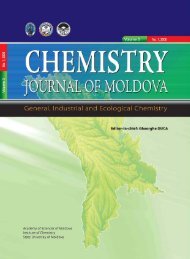2011, nr. 3 - Academia de ÅtiinÅ£e a Moldovei
2011, nr. 3 - Academia de ÅtiinÅ£e a Moldovei
2011, nr. 3 - Academia de ÅtiinÅ£e a Moldovei
Create successful ePaper yourself
Turn your PDF publications into a flip-book with our unique Google optimized e-Paper software.
346Buletinul AŞMother metabolic disturbances, such as glycemic disor<strong>de</strong>r,hypertriglyceri<strong>de</strong>mia and low HDL cholesterol,suggest that that the elevated GGT levels can help inthe prediction of the <strong>de</strong>velopment of metabolic syndromeas well as the type II diabetes mellitus. HigherGGT levels in obese persons, particularly those withabdominal obesity, is another important associationbetween GGT and metabolic syndrome. This associationis further strengthened by an existent correlationbetween GGT and arterial hypertension. Therefore, ithas been <strong>de</strong>monstrated that practically all major componentsof the metabolic syndrome correlate with thehigher serum GGT activity.Cardiovascular diseasesSerum GGT activity level correlates with the riskof fatal events in patients with chronic forms of coronaryheart disease, congestive heart failure as well asboth ischemic and hemorrhagic stroke. This is equallytrue for both sexes, with a clear enzyme concentration-cardiovascularrisk relationship. The strongerprognostic significance of GGT was <strong>de</strong>termined inyounger persons. In the same time the mechanism ofassociation between GGT and cardiovascular risk isnot yet clear. Although, the mechanism un<strong>de</strong>rlying theabove associations remains largely unknown, it can besupposed that the serum GGT activity might be associatedwith cardiovascular risk through a mechanismrelated to oxidative stress: many experimental studieshave shown that GGT plays an important role in antioxidant<strong>de</strong>fense systems at cellular level [8, 18].Moreover, dietary heme iron was positively associatedwith serum GGT concentrations, whereasmost dietary antioxidants, especially vitamin C andbeta-carotene, were inversely associated with serumGGT activity [7].Although there is no doubt consi<strong>de</strong>ring the useof GGT as an in<strong>de</strong>x of liver function, there are nowsome indications of the direct involvement of GGThaving in the atherosclerotic plaque formation. [19]It has been suggested recently that GGT may have arole in the pathogenesis of atherosclerosis: GGT activityhas been <strong>de</strong>tected in atheromatous plaques ofcarotid and coronary arteries, and it has been shownthat glutathione hydrolysis by GGT can trigger ironcatalysedlow-<strong>de</strong>nsity lipoprotein (LDL) oxidation[20], as well as production of reactive oxygen species[21]. These events are known to play a centralrole in the evolution of atherosclerosis: formation ofthe fibrous cap [22], apoptosis of cellular elementsof the lesion [23], plaque erosion and rupture [24],enhanced platelet aggregation and thrombosis.The possible role of GGT in the atheroscleroticprocess suggests that its predictive value is at leastpartly in<strong>de</strong>pen<strong>de</strong>nt of self-reported alcohol consumption.On the other hand, alcohol consumption hasbeen confirmed to have a protective effect againstmyocardial infarction [25].However, because of its availability as well aslow screening costs, higher than expected GGT levelsin otherwise healthy individuals suggest a more<strong>de</strong>tailed patient’s examination. The following therapycan eventually prevent cardiac-related events and<strong>de</strong>aths in the future [26].ConclusionsAs has been shown in epi<strong>de</strong>miological studies,GGT seems to be an appropriate marker of fatty liverdisease, if known factors that can cause a GGT elevationhave been addressed properly (e.g alcohol consumptionand hepatitis B and C infections).However, in the upper reference range, GGT hasbeen found to be a strong in<strong>de</strong>pen<strong>de</strong>nt biomarkerfor the metabolic syndrome (insulin resistance syndrome),which is associated with a casca<strong>de</strong> of abnormalitiesin the thiol redox system. GGT is also anin<strong>de</strong>pen<strong>de</strong>nt risk marker for the <strong>de</strong>velopment of cardiovasculardisease. It correlates positively with age,sex, triglyceri<strong>de</strong>s, blood pressure, body mass in<strong>de</strong>x,low-<strong>de</strong>nsity lipoprotein cholesterol, fasting glucose,ethanol ingestion, and smoking – well known cardiovascularrisk factors.Further aca<strong>de</strong>mic studies will need to be done toevaluate GGT’s overall importance, especially as anin<strong>de</strong>pen<strong>de</strong>nt risk factor, that can be used for predictingthe <strong>de</strong>velopment of the metabolic syndrome andcardiovascular diseases.Bibliography1. Meister A. Metabolism and transport of glutathioneand other gamma-glutamyl compounds. In: Larsson A,Orrenius S, Holmgren A, Mannervik B, eds. Functionsof glutathione: biochemical, toxicological and clinicalaspects. New York: Raven Press; 1983: 1–22.2. Green RM, Flamm S. AGA technical review on theevaluation of liver chemistry tests. Gastroenterology 2002;123:1367– 84.3. Whitfield JB, Zhu G, Nestler JE, Heath AC,Martin NG. Genetic covariation between serum gammaglutamyltransferaseactivity and cardiovascular riskfactors. Clin Chem 2002; 48:1426–31.4. Lee DH, Jacobs DR Jr, Gross M, Kiefe CI, RosemanJ, Lewis CE, et al. Gamma-glutamyltransferase is a predictorof inci<strong>de</strong>nt diabetes and hypertension: the Coronary ArteryRisk Development in Young Adults (CARDIA) Study. ClinChem 2003; 49:1358– 66.5. Emdin M, Pompella A, Paolicchi A. Gammaglutamyltransferase,atherosclerosis, and cardiovasculardisease: triggering oxidative stress within the plaque.Circulation 2005; 112:2078– 80.6. Pompella A, Emdin M, Passino C, Paolicchi A.The significance of serum gamma-glutamyltransferase
















